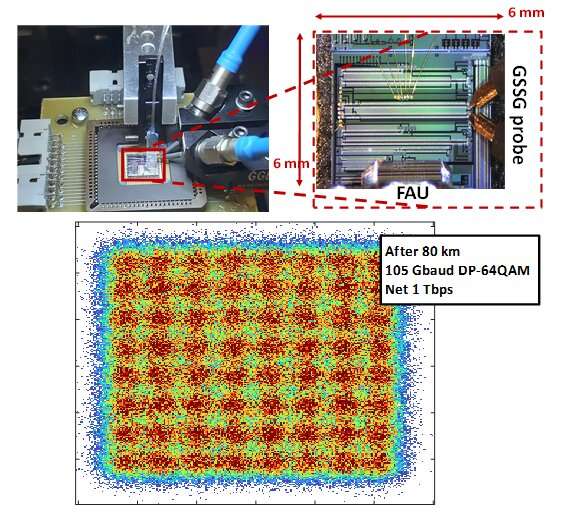A silicon photonic modulator supporting the 800G standard for high-speed data transmission

In wireless communication, G stands for “generation” as in 4G, 5G, 6G. When it comes to data rate in optical communications though, “G” stands for gigabits per second (Gbps), and the progression doubles, as in 100G, 200G, 400G and 800G.
Optical communication travels at the speed of light, but the rate limiting step is often the encoding of information in a communication channel, known as the baud rate. Today’s 400G-type coherent interfaces are based on 60 gigabaud (Gbaud) protocols which would theoretically need to double to 120 Gbaud to support the new 800G standard. However, electro-optic components find it very challenging to operate at 120 Gbaud. Insert research here to find a solution.
In their paper “Silicon Photonic Single-Segment IQ Modulator for Net 1 Tbps/λ Transmission Using All-Electronic Equalization,” a team of researchers at McGill University and Ericsson Canada, makers of telecom equipment, have demonstrated communication at 105 Gbaud with net 1 Tbps optical transmission using standard chip technology and data-encoding algorithms.
Stepping back a little bit, the paper is announcing a record-breaking data rate of 1 Terabits per second (Tbps) when the standard is going to be 800 Gbps. Running a back-of-the-envelope calculation and ignoring the vagrancies of binary math—if 1000 Gbps = 1 Tbps—then we’re 20% faster than need be, yes?
The point is that the team achieved a milestone (1 Tbps) for a hot topic technology proving there’s room to perfect and commercialize this modulator for telecommunications systems built to run on the 800G standard. The new systems will then be draped across the ocean floor to replace the old Internet fiber.
To support commercialization, the team has made various practical decisions, choosing to design around technical difficulties. The team has chosen an all-silicon photonics (SiP) platform fabricated using CMOS (pronounced “sea-moss”) technology. CMOS devices have high noise immunity and low power consumption. Given how much fabrication infrastructure is in place, they are relatively low cost to produce. Another fixed variable is that the team is operating in classic C-band, with wavelengths (λ) between 1530 and 1565 nm.
The team focuses on design factors and analyzes tradeoffs. The team fabricated In-phase quadrature modulators (IQM) with two different phase shifter lengths and used an advanced modulation format to test for speed and quality in data communication. The team used a sophisticated, but standardized, quadrature amplitude modulation (QAM) algorithm, to encode multiple bits of data onto a single light pulse. This gets back to the baud rate that can be supported.
The IQMs modulate both the amplitude and phase of light and support polarization multiplexing. The paper documents performance of both single polarization and dual-polarization transmission results along with the optical signal-to-noise ratio performance. Note that currently, the encoding of information uses a dual-polarization (DP) 16 QAM format.
Here are the team’s results using all electronic equalization:
- Using single polarization, the team transmitted net 413 Gbps (95 Gbaud 32QAM) over 80 km of standard single-mode fiber under the 14.8% overhead concatenated forward error correction (C-FEC) bit-error-rate threshold of 1.25 × 10−2.
- Using dual-polarization emulation and lookup table-based nonlinear pre-distortion, the team demonstrated a transmission of 95 Gbaud DP-32QAM and 115 Gbaud DP-16QAM over 80 km of fiber below the C-FEC bit-error-rate threshold, corresponding to net rates of 827 Gbps and 800 Gbps, respectively.
- The team transmitted 105 Gbaud DP-64QAM over 80 km below the 25% overhead soft-decision FEC bit-error-rate threshold of 5 × 10−2, at a net 1 Tbps transmission.
All before the black-and-white checkered flag even dropped.
More information:
Essam Berikaa et al, Silicon Photonic Single-Segment IQ Modulator for Net 1 Tbps/λ Transmission Using All-Electronic Equalization, Journal of Lightwave Technology (2022). DOI: 10.1109/JLT.2022.3191244
Provided by
Institute of Electrical and Electronics Engineers
Citation:
A silicon photonic modulator supporting the 800G standard for high-speed data transmission (2023, June 14)
retrieved 14 June 2023
from https://techxplore.com/news/2023-06-silicon-photonic-modulator-800g-standard.html
This document is subject to copyright. Apart from any fair dealing for the purpose of private study or research, no
part may be reproduced without the written permission. The content is provided for information purposes only.
For all the latest Technology News Click Here
For the latest news and updates, follow us on Google News.
